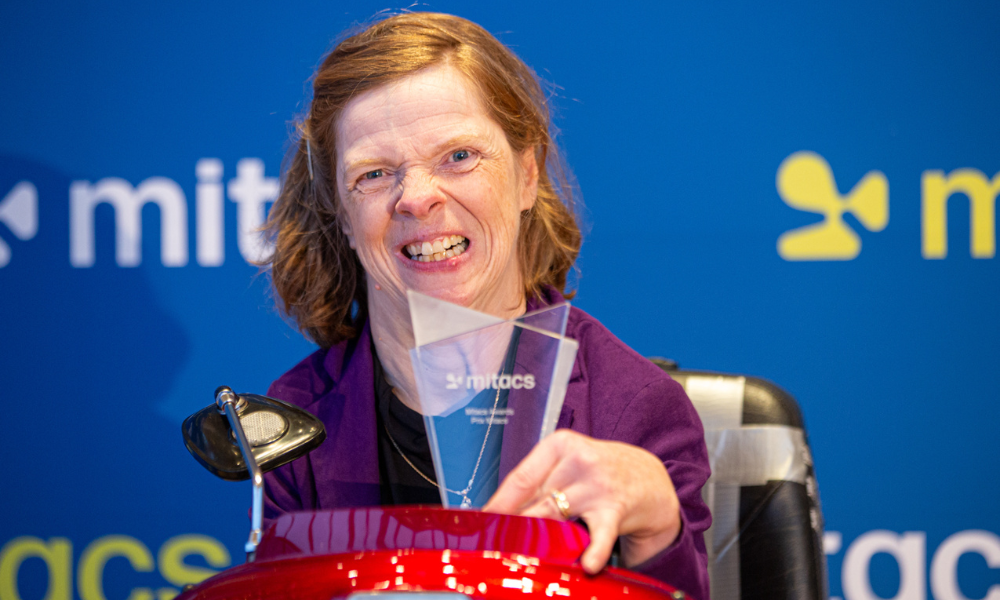Universal design seen as key way to accommodate employees: Canadian researcher

“Employers can start by including inclusion statements on job postings and websites. This sends a powerful message of welcome to all.”
So says Glenda Watson Hyatt, researcher at Queen’s University in Kingston, Ont. about how best to be accepting and inclusive as an employer, especially for those who have speech disabilities.
Watson Hyatt — who has lived more than 41 years with cerebral palsy, has a speech impairment and uses a wheelchair — recently completed a study around some of the biggest challenges faced by her cohorts in gaining meaningful employment.
“This research aimed to collect and analyze the lived experiences from employees living with speech disabilities to better understand the barriers that have existed and still exist for them within the general labour market, and to identify gaps and current practices in employing this segment of the Canadian population,” says Watson Hyatt.
“What jumped out at me from the results is how the solutions are not necessarily big budget items.”
Watson Hyatt recently was honoured with a Mitacs Award for Outstanding Innovation Master’s for the study.
Awareness sorely needed around people with disabilities
Currently, more than 500,000 Canadians are living with speech disabilities and the study shines a light on some of their biggest obstacles to employment, such as an unemployment rate of 51%, which rises to 86% for people with speech disabilities.
“The most significant finding that we heard from nearly all of our participants is the biggest barrier to finding and retaining employment is the lack of awareness and acceptance of people with speech disabilities. The systemic discrimination and ableism against this segment of the disabled population is difficult to navigate when seeking employment, and can cause unnecessary physical and mental stress,” says Watson Hyatt.
Businesses in Ontario have until Dec. 31 to file an updated accessibility compliance report, under the Accessibility for Ontarians with Disabilities Act (AODA).
Using design as best way to help disabled employees
Her work focused on using a model to allow organizations to be truly embracing of those workers to fill the labour gap. It deployed the Six Sigma engineering problem-solving method, and she is also working on a framework organizations can use.
“Instead of relying solely on accommodations, employers can embrace universal design, making their workplace accessible to everyone, regardless of ability and thus fostering a more inclusive environment,” says Watson Hyatt.
“However, when individualized accommodations are needed, simplify the process so that it is less onerous on the employee to request what they need to be successful at their job.”
This effort can be started before the prospective employee has come onboard.
“Build a culture of openness by starting with asking every candidate ‘What would help you become successful in your interview?’” says Watson Hyatt.
But as with many things, a sense of curiosity and empathy goes a long way toward true acceptance.
“Employers can educate themselves and their workforce about people with speech disabilities. This task need not fall solely to employees living with disabilities. Champions and allies are essential in supporting inclusive work environments,” she says.
Watson Hyatt’s study will be used by the Canadian Council of Rehabilitation and Work (CCRW) programs to support such workers.
What can HR do to build inclusion?
For HR to make the process of assisting disabled employees run seamlessly, it can begin with adopting the correct perspective, says Watson Hyatt.
“Shifts in awareness, attitudes and acceptance would go a long way in eliminating these barriers. Build a workplace culture of openness and curiosity. Ask everyone what they need to be successful because everyone needs accommodations, whether it be to leave early Wednesday afternoons for a kid’s soccer practice, a quiet place to pray, or swapping telephone duties for another responsibility more suitable to someone with a speech disability.
“Value people with disabilities and discover what they can offer,” she says.




